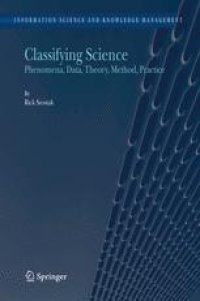
Ebook: Classifying Science: Phenomena, Data, Theory, Method, Practice
Author: Rick Szostak (auth.)
- Tags: Science general, Philosophy of Science, Interdisciplinary Studies, Library Science, Methodology of the Social Sciences
- Series: Information Science and Knowledge Management 7
- Year: 2004
- Publisher: Springer Netherlands
- Edition: 1
- Language: English
- pdf
Classification is the essential first step in science. The study of science, as well as the practice of science, will thus benefit from a detailed classification of different types of science.
In this book, science - defined broadly to include the social sciences and humanities - is first unpacked into its constituent elements: the phenomena studied, the data used, the theories employed, the methods applied, and the practices of scientists. These five elements are then classified in turn. Notably, the classifications of both theory types and methods allow the key strengths and weaknesses of different theories and methods to be readily discerned and compared. Connections across classifications are explored: should certain theories or phenomena be investigated only with certain methods? What is the proper function and form of scientific paradigms? Are certain common errors and biases in scientific practice associated with particular phenomena, data, theories, or methods? The classifications point to several ways of improving both specialized and interdisciplinary research and teaching, and especially of enhancing communication across communities of scholars. The classifications also support a superior system of document classification that would allow searches by theory and method used as well as causal links investigated.
Classification is the essential first step in science. The study of science, as well as the practice of science, will thus benefit from a detailed classification of different types of science.
In this book, science - defined broadly to include the social sciences and humanities - is first unpacked into its constituent elements: the phenomena studied, the data used, the theories employed, the methods applied, and the practices of scientists. These five elements are then classified in turn. Notably, the classifications of both theory types and methods allow the key strengths and weaknesses of different theories and methods to be readily discerned and compared. Connections across classifications are explored: should certain theories or phenomena be investigated only with certain methods? What is the proper function and form of scientific paradigms? Are certain common errors and biases in scientific practice associated with particular phenomena, data, theories, or methods? The classifications point to several ways of improving both specialized and interdisciplinary research and teaching, and especially of enhancing communication across communities of scholars. The classifications also support a superior system of document classification that would allow searches by theory and method used as well as causal links investigated.
Classification is the essential first step in science. The study of science, as well as the practice of science, will thus benefit from a detailed classification of different types of science.
In this book, science - defined broadly to include the social sciences and humanities - is first unpacked into its constituent elements: the phenomena studied, the data used, the theories employed, the methods applied, and the practices of scientists. These five elements are then classified in turn. Notably, the classifications of both theory types and methods allow the key strengths and weaknesses of different theories and methods to be readily discerned and compared. Connections across classifications are explored: should certain theories or phenomena be investigated only with certain methods? What is the proper function and form of scientific paradigms? Are certain common errors and biases in scientific practice associated with particular phenomena, data, theories, or methods? The classifications point to several ways of improving both specialized and interdisciplinary research and teaching, and especially of enhancing communication across communities of scholars. The classifications also support a superior system of document classification that would allow searches by theory and method used as well as causal links investigated.
Content:
Front Matter....Pages i-xv
Classifying Science....Pages 1-22
Classifying Phenomena and Data....Pages 23-50
Classifying Theory....Pages 51-98
Classifying Method....Pages 99-154
Classifying Practice....Pages 155-198
Drawing Connections Across These Classifications....Pages 199-216
Classifying Scientific Documents....Pages 217-238
Concluding Remarks....Pages 239-268
Back Matter....Pages 269-287